One of the biggest mistakes that a relatively inexperienced system builder will make is to place all the component focus on the most powerful processor, motherboard and graphics card while trying to save money on the power supply – often ending up with a no name brand from China.
When I am building a new rig I generally work out the power I will need first then buy the best supply I can afford while leaving enough headroom for a possible upgrade. Seasonic are without question one of the finest enthusiast power supply brands in the world and over the years I have entrusted their products to power many of my own systems, both at home and work. I would go as far to say that they have proven the most reliable brand of power supplies I have tested in the last seven years on KitGuru.
If you read further down this page, you will see that Seasonic power supplies have won many awards on KitGuru over the years. All of these power supplies I reviewed myself, so I know for a fact how well they are made. Seasonic power supplies all use quality Japanese capacitors and internally their soldering quality is always stellar. You really do not want a power supply with cheap Chinese capacitors, unless you are very very restricted in budget.
I have been called upon to investigate many systems suffering from instability, black screen hardlocks, blue screens of death and overclocking issues. More often than not, its because of a cheap nasty power supply installed. Don't cut corners is always my advice.
But how do you know which power supply you need?
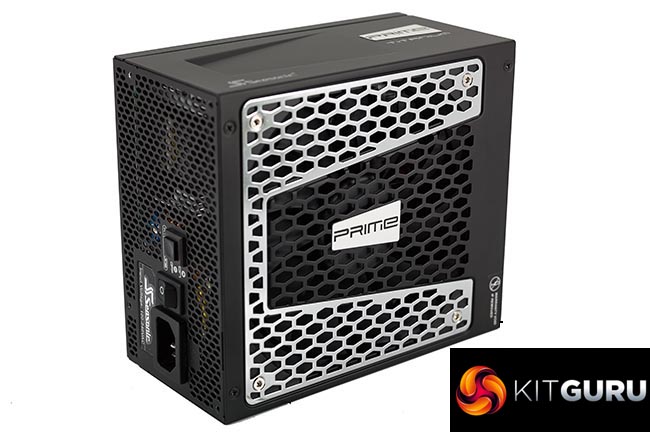
If you have a system chassis with a window and are focusing on a tidy system build, then you will more than likely want to buy a modular power supply. There are several kinds of modular power supply available today. A ‘Pure’ modular power supply will have no hardwired cables. This means when you open the box and remove the power supply, there won’t be any cables dangling from the unit itself. A separate bag will be supplied, with every cable in it.
Other modular power supplies will have some cables hardwired into the chassis. These hardwired cables will often be the main motherboard connector, and perhaps a couple of PCIe cables and the CPU 8/4 pin connector – these primary cables are generally used all the time.
If you don’t get a modular power supply, then you will end up dealing with a plethora of cables you might not be using. All of these will need carefully routed out of sight behind the motherboard tray. Depending on the case you are using and the specific power supply, this can get messy.
Many computer cases don’t have a lot of space behind the motherboard tray, so you will need to get creative. If cable routing is a high priority for you, we advise you opt for one of the modular supplies currently available online. You won't be trying to hide a snakes nest of cables you don't need.
Don’t just blindly buy a power supply with a 1250W+ rating, especially if it is in the bargain basement section. Unless you are running an ultra high end system with multiple graphics cards you are highly unlikely to need one. Of course you could have a system that incorporates two AMD R9 295X2 graphics cards (like this one we tested HERE) but in the real world, it is very unlikely you will need a 1.250 watt or 1,500 watt power supply. Aim for quality of watts, not quantity.
A good example is that a high end gaming system using an overclocked Core i7 Skylake processor with Nvidia GTX1080 is likely to be only demanding between 300-400 watts of power under load. Many people would think just because a system is using a high end graphics card that a 1000W power supply is immediately needed. It isn’t. Also it is worth bearing in mind that lesser brands with high wattage ratings will not be delivering the same standard of power as a quality design.
That said, I have seen some poorly written guides shared online. If you have a system that uses 600 watts of power when gaming under load, then a 1000 watt power supply is actually a pretty shrewd investment – because you will be hitting around 60% demand under full load – this means the power supply will be operating at, or close to maximum efficiency. Noise levels will be lower, as the fan will be spinning relatively slowly. The higher rated capacitors will also be less stressed.
A power supply will reach maximum efficiency between 40% and 60% of its maximum rated load. It is also always prudent to leave a little headroom to add in some additional hardware at a later date. Ideally you don't want to be running a power supply at above 80% full output on a regular basis. Not only will it be operating outside maximum efficiency parameters, but the fan will likely be working much harder to maintain the thermal curve. A faster spinning fan means more noise, which none of us want.
Obviously this is only part of the procedure for buying the right power supply. You can also factor in the 80 Plus certification. This is the certification of rated efficiency. This will certify products that have more than 80% energy efficiency at 20%, 50% and 100% of rated load, and a power factor of 0.9 or greater at 100% load. That is, such power supplies will waste 20% or less electric energy as heat at the specified load levels, thus reducing electricity use and bills compared to less efficient power supplies.
We would always recommend at least 80 Plus Bronze certification for a budget power supply and when you spend more money, this certification will increase to Silver, Gold, Platinum and Titanium certification. Platinum and particularly Titanium power supplies are still very expensive – 80 Plus Gold units have proven popular with the enthusiast audience in the last couple of years as they combine high levels of efficiency at a reasonable price point.
Be aware that some power supplies don’t achieve their claimed efficiency levels. There have been many articles on this in the past and it certainly complicates the issue. Just because you see an 80 Plus Gold badge on the front of the box, it doesn’t mean the power supply actually has been certified. That said, all of the Seasonic power supplies shown at the bottom of this page have achieved their efficiency rating.
Ripple performance is also an important factor when deciding on a power supply, because if a specific unit falls outside industry tolerance specifications, it can be potentially dangerous. Ripple occurs with all SMPSU’s (switch mode power supply units). These are tiny fluctuations in a power supplies output voltage on the order of tens of millivolts, millions of times a second. Ripple is measured as a peak-to-peak value in milivolts and is measured using an oscilloscope. We detail this, and more, in all KitGuru power supply reviews.
The ATX specification sets these limits on computer PSU ripple levels (meaning we don’t want to see results in excess of these figures below):
+12V – 120mV
+5V – 50mV
+3.3V – 50mV
+5VSB – 50mV
Ideally (in my opinion) we want to see figures in this range:
+12V – 80mV
+5V – 35mV
+3.3V – 35mV
+5VSB – 50mV
A power supply which shows ripple outside (higher) than that listed by the ATX specifications can potentially cause hardware damage. There is no way of measuring when a problem might occur, but it is likely something will go wrong, long term. A power supply that shows good ripple suppression will help aid hardware longevity.
Ripple can have a negative impact on electrolytic capacitors. A ripple reading close to a capacitors rated ripple will potentially shorten the lifespan and ripple exceeding its rated level could cause it to blow. It is worth pointing out that electrolytic capacitors are found on a motherboard, a graphics card, the power supply and more – so the potential for damage is high. Using a power supply with good ripple suppression is very important. If you want to learn more about this, there are plenty of indepth technical articles available online.
Additionally, If you are trying to build a quiet system it is important to factor in the fan performance of the unit. A fan that has to work hard to maintain good internal ambient temperatures will likely produce a lot of noise which can be distracting, especially if the rest of your system has been built with silence in mind. We also detail this in our reviews.
Below are some of the finest Seasonic power supplies we have reviewed in the last 24 months – targeting various price points and system demands. All of these units have been thoroughly analysed by myself and have earned our highest awards – you can click the images of the power supplies below and read the indepth reviews.
Seasonic are not the only quality power supply manufacturer whose products I have analysed over the last decade, but their level of consistency throughout the ranges really has proven in our lab testing to be second to none.
Allan ‘Zardon' Campbell
KitGuru Limited Managing Director and Editor In Chief.
Seasonic PRIME 1000W Gold Power Supply |
Seasonic PRIME 650W Platinum Power Supply
|
Seasonic PRIME 850 Platinum Power Supply |
||
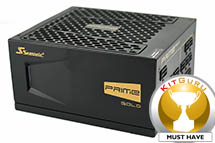 |
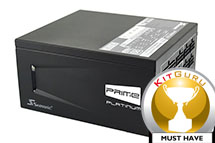 |
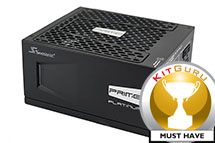 |
||
| As we had expected, the Seasonic PRIME 1000W Gold power supply delivers very high quality power and technically there is very little to fault. The quality of the build is exemplary, and the chassis between all three series is basically identical, with only minor cosmetic changes to differentiate.
Seasonic offer a full 12 year warranty with all these power supplies, so you can rest assured you are supported down the line in event of any issues developing. |
The Seasonic PRIME 650W Platinum is another fantastic power supply from a company who can do very little wrong in recent years. The build quality is exemplary and technically it is difficult to find fault with this unit.
Load regulation is stellar and the power supply exhibited no issues when dealing with the intensive cross load test. Ripple suppression is also noteworthy and we recorded a >94% peak efficiency. |
Seasonic don’t skimp on quality and have yet again opted for high grade 105c rated Japanese capacitors throughout. They seem so assured of their own quality that they raised the warranty on their units from 10 years to 12 years.
Anyone buying a new Seasonic power supply should feel pretty confident that they are fully covered. |
||
| Pros | Pros | Pros | ||
|
|
|
||
| Cons | Cons | Cons | ||
|
|
|
||
| KitGuru says: | KitGuru says: | KitGuru says: | ||
| Another killer power supply from Seasonic. The PRIME 1000W Gold hits a sweet spot just under £200. It is able to deliver over 1200 watts before shut down, so its very over specified. Another £20 will get you the superior PRIME Platinum version however. | The Seasonic PRIME 650W Platinum is another great power supply from a company who can do no wrong lately. It does fall a little short when compared directly to the more expensive PRIME 650W Titanium unit however. | The Seasonic PRIME 850W Platinum is yet another great power supply with class leading 12 year warranty. |
Seasonic PRIME Platinum 1200w Power Supply
|
Seasonic PRIME Titanium 650w Power Supply |
Seasonic PRIME Titanium 850w Power Supply
|
||
 |
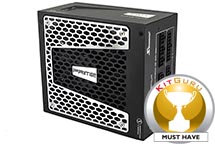 |
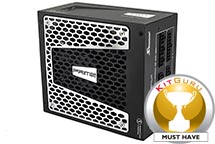 |
||
| It is true most gaming systems won’t need a 1200 watt power supply, but ideally you want to be running between 40%-60% load to achieve the maximum efficiency levels.
It is also worth pointing out that running a 600 watt power supply at 100% load will put a lot of strain on the capacitors and cause the fan to work very hard whereas you will be hitting that sweet spot on a PRIME 1200W close to maximum efficiency with much lower noise levels. |
Seasonic have spared no expense in the design of the Titanium Prime. They have created a cable free connection design with a copper plate connecting the main PCB to the back panel for increased reliability and enhanced performance. They have adopted high grade Nippon Chemi Con 105c rated capacitors in the primary stage, with 105c rated capacitors also incorporated into the secondary stage. | Technically it is difficult to find anything to fault. The Titanium rated power supply excels in load regulation and ripple suppression, hitting a top 2% of units we have tested in the last year. Power delivery is stellar – we were able to hold close to a 1000 watt load for an extended period of time without a problem. Over-specifying power delivery has been a Seasonic feature for some time, so it is reassuring to see that this has not changed in 2016. | ||
| Pros | Pros | Pros | ||
|
|
|
||
| Cons | Cons | Cons | ||
|
|
|
||
| KitGuru says: | KitGuru says: | KitGuru says: | ||
| The 1200W Seasonic PRIME Titanium power supply is technically fantastic and able to power any system on the market today. It is over specified and able to deliver more than 1340 watts before shutting down safely. No expense is spared internally and the class leading 12 year warranty is certainly reassuring. | The Seasonic Prime 650W Titanium power supply is another incredibly high grade unit that will suit the audience who want to ensure they are feeding the best possible power to all their expensive components. | The Seasonic Prime 850W Titanium power supply is one of the best power supplies we have ever tested. It is priced accordingly, but if you want the best power for your new system build, this unit gets our highest recommendation. |
Some older Seasonic units below — some of these are still available in etailers, great if you can pick up a bargain.
 KitGuru KitGuru.net – Tech News | Hardware News | Hardware Reviews | IOS | Mobile | Gaming | Graphics Cards
KitGuru KitGuru.net – Tech News | Hardware News | Hardware Reviews | IOS | Mobile | Gaming | Graphics Cards


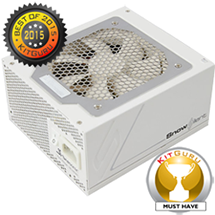
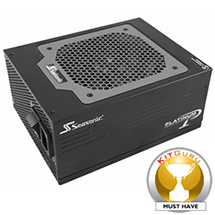
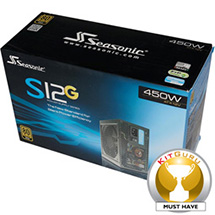

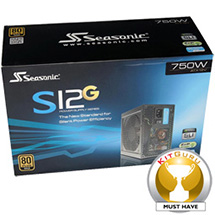
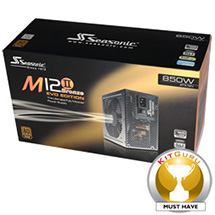

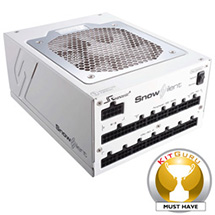
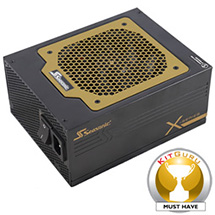

Is this a paid endorsement?
Probably just keeping their advertisers happy………………….
Having read lot’s of PSU reviews on various sites,and come across comments like-
“not up to Seasonics standard”
“almost as good as Seasonic”
Have come to the conclusion “SEASONIC” are what others are measured by.
So have no problem with article like this……………………..
I don’t mean to imply that it’s bad if this is the case as the information is based on Allan’s previous reviews- just that transparency is always good.
For an example of a not so good promotional piece, take a look a techpowerup’s “review” of the RX 560 vs. GTX 1050. It’s written by AMD. I understand ad revenues are taking a beating but come on.
No, I can honestly say Seasonic haven’t paid anything for this article. They are an advertiser as you might see but this article was something i made myself without even their knowledge or input.
I do however personally rate their products highly based on all my reviews over the years, so I do recommend their products to most people who ask me. I don’t get paid for that either, but its an honest opinion.
Of course I understand people might think this is a paid endorsement, but Seasonic really don’t have to pay me to endorse their products. The quality alone does that.
I also have tried to help explain about buying a power supply and what you need to look out for, and why, so I consider this a ‘non paid for buying advice’.
Nothing to hide- thats why Seasonic are even in the title of the editorial. I haven’t tried to cover up my respect for the brand. There are honestly very few brands with great power supplies at all price points – Seasonic are probably the only one that comes to mind if I was being 100% truthful. All based on my testing and reviews over the year.
Thanks for the input,
Allan.
CNN is paying 97$ per hour! Work for few hours and have longer with friends & family,,,Here’s how to make additional cash each week…On tuesday I got a great new Land Rover Range Rover from having earned 9036 Dollars this last four weeks.. Its the most-financialy rewarding I’ve had.. Learn more about it on following link
http://www.Best21.Com..
I appreciate the background if nothing else. As a sort of casual gamer (build my own PC, but I base that largely on recommendations from experts), it’s accessible and interesting.
Only One psu missing from this great article! And it’s the one I’ve been waiting for for over 5 months? can anyone guess which titanium seasonic I’m referring too? 😉 I’ll give you a clue its completely silent!